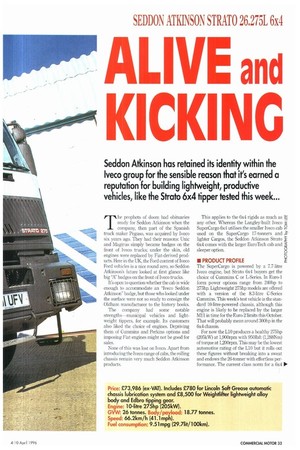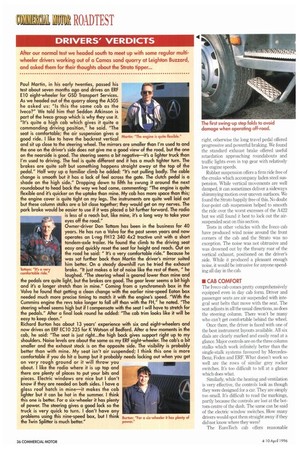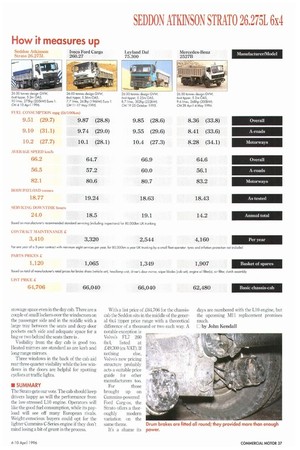Seddon Atkinson has retained its identity within the Iveco group
Page 35

Page 36

Page 38

Page 39

If you've noticed an error in this article please click here to report it so we can fix it.
for the sensible reason that it's earned a reputation for building lightweight, productive vehicles, like the Strato 6x4 tipper tested this week...
The prophets of doom had obituaries ready for Seddon Atkinson when the ..1410641is company, then part of the Spanish , ' truck maker Pegaso, was acquired by Iveco
six years ago. They had their reasons: Unic and Magirus simply became badges on the front of Iveco trucks; under the skin, old engines were replaced by Fiat-derived products. Here in the UK, the Ford content of Iveco Ford vehicles is a nice round zero, so Seddon Atkinson's future looked at first glance like big" A'.' badges on the front of Iveco trucks.
mill It's open to question whether the cab is wide enough to accommodate an "Iveco Seddon Atkinson" badge, but those who looked under the surface were not so ready to consign the Oklham manufacturer to the history hooks.
The company had some notable strengths—municipal vehicles and lightweight tippers, for example, Its customers also liked the choice of engines. Depriving them of Cummins and Perkins options and imposing Fiat engines might not be good for sales.
None of this was lost on Iveco. Apart from introducing the Iveco range of cabs, the rolling chassis remain very much Seddon Atkinson products.
This applies to the 6x4 rigids as much as any other. Whereas the Langley-built Iveco SuperCargo 6x4 utilises the smaller Iveco cab used on the SuperCargo 17-tonners and lighter Cargos, the Seddon Atkinson Strata 6x4 comes with the larger EuroTech cab and g sleeper option.
• PRODUCT PROFILE
The SuperCargoSuperCargo is powered by a 7.7-litre Iveco engine, but Strato 6x4 buyers get the choice of Cummins C or L-Series. In Euro-1 form power options range from 240hp to 275hp. Lightweight 275hp models are offered with a version of the 8.3-litre C-Series Cummins. This week's test vehicle is the standard 10-litre-powered chassis, although this engine is likely to be replaced by the larger M11 in time for the Euro-2 limits this October. That will probably mean around 300hp in the 6x4 chassis.
For now the L10 produces a healthy 275hp (205kW) at 1,900rpm with 950113ft (1,288Nm) of torque at 1,200rpm. This may be the lowest automotive rating of the L10 but it rolls out these figures without breaking into a sweat and endows the 26-tonner with effortless performance. The current class norm for a 6x4
• chassis is 270hp but the L10 offers 35% more torque than the Iveco Ford SuperCargo, 14% more than the 8.7-litre Leyland Daf 75.300 and 18% more than the Mercedes 2527, giving it one of the biggest torque outputs available in a 6x4 tipper chassis.
As with the engines, there is a choice of gearboxes. CM's test truck came with the standard Eaton RT11609A direct-top, constant-mesh nine-speed box. Those operating in hilly country may prefer the optional 12-speed Eaton Twin Splitter with deeper gearing at the bottom end. Seddon Atkinson has recently stopped fitting the Cablecraft cable gear linkage and opted for a rod linkage instead, but our M-registered test vehicle came with the superseded cable setup. Since the Iveco cab is supplied with a rod linkage as standard and Seddon Atkinson had been removing them to fit the cable linkage, the change makes a great deal of sense.
A twin-plate ceramic clutch, adequately suited to tipper life, takes the drive to the Rockwell rear bogie. Cross and inter-axle difflocks are standard. Like its Supercargo cousin, rear suspension is by Hendrickson Norde rubber with parabolic steel at the front.
Our Strato was also fitted with the optional vertical exhaust and Lincoln Soft Grease automatic chassis lubrication system. Seddon Atkinson offers three wheelbase options—we tested the shortest (4.52m) option fitted with a Weightlifter alloy body and Edbro front-end tipping gear.
• PRODUCTIVITY
The big cab and 10-litre engine do not help all-up weight. Seddon quotes 7.23 tonnes for the 4.52m chassis giving a body/payload potential of 18.77 tonnes. Not surprisingly, the light Iveco Ford offers nearly half a tonne more but the Seddon is ahead of both the Leyland Daf 75.300 and Mercedes-Benz 2527.
Overall, we returned 9.51mpg (29.71it/100km) around our Midlands tipper route. This is not so far behind the 9.87mpg (28.814/100km) we recorded with the Iveco Ford and a marked improvement on the 8.36mpg (33.01it/100km) we managed with the Mercedes. On the motorway section we even broke the lOmpg barrier with 102mpg (27.71it/100km).
The result was good by 6x4 standards and up with the best performers in class despite its 10-litre engine. No doubt the plentiful torque helped to minimise gear changes and thus conserved fuel.
It may also have helped to maintain speed as the Seddon covered the ground at a commendable overall average speed of 66,2km/h (41.1mph).
Our verdict? A good performance with fine overall fuel consumption and journey times but without any significant weight handicap. • ON THE ROAD The Seddon should not draw many complaints from drivers. The U0 makes the Strata an easy drive: although maximum torque is produced at 1,200rpm, the 10-litre engine is happy to lug down to around 1,000rpm before it gives up. In places where we would expect to change down on the Aroad section, the Seddon was happy to bumble along in top. The Sun Rising Hill climb was dispatched in 2min 31sec; some seven seconds faster than the next quickest of our listed rivals and no less than 24 seconds quicker than the Iveco SuperCargo.
In our experience cable gear linkages either work very well or very badly. Luckily for us, the Sn-ato offered a light and swift change. Lack of precision was our biggest criticismSeddon's decision to revert to rod linkages is one we applaud. That leaves Foden alone with a cable change so let's hope it's not long before they also switch to a more consistent system.
Most changes up and down could be taken without the clutch which was just as well. Even with air assistance it is heavy by modern standards. A few minutes' manoeuvring was enough to induce knee ache.
The Seddon impressed us with the stopping power of its all-drum braking system. it pulled up very quickly in our panic stop tests at MIRA: from 64kin/h (40mph) we locked up the back axle and experienced a pull to the right, otherwise the long travel pedal offered progressive and powerful braking. We found the standard exhaust brake offered useful retardation approaching roundabouts and traffic lights even in top gear with relatively low engine speeds.
Rubber suspension offers a firm ride free of the creaks which accompany laden steel suspension. While vertical movements are well damped, it can sometimes deliver a sideways shimmying motion over uneven surfaces. We found the Strata happily free of this. No doubt four-point cab suspension helped to smooth the ride over the worst excesses of the A422 but we still found it best to lock out the airsuspended seat on this section.
Tests in other vehicles with the Iveco cab have produced wind noise around the front corners of the cab and the Strato was no exception. The noise was not obtrusive and was drowned out by the throaty roar of the vertical exhaust, positioned on the driver's side. While it produced a pleasant enough noise, it would be intrusive for anyone spending all day in the cab.
• CAB COMFORT The Iveco cab comes pretty comprehensively equipped even in day cab form. Driver and passenger seats are air suspended with integral seat belts that move with the seat. The seat adjusts in all the usual directions, as does the steering column. There won't be many who can't get comfortable behind the wheel.
Once there, the driver is faced with one of the best instrument layouts available. All six dials are clearly marked and easily read at a glance. Major controls are on the three column stalks which work infinitely better than the single-stalk systems favoured by MercedesBenz, Foden and ERF. What doesn't work so well are the rows of similar grey rocker switches. It's too difficult to tell at a glance which does what.
Similarly, while the heating and ventilation is very effective, the controls look as though they were designed for a car. They are simply too small. It's difficult to read the markings, partly because the controls are lost at the bottom centre of the dash. The same can be said of the electric window switches. How many drivers would spot them straight away if they did not know where they were?
The EuroTech cab offers reasonable stowage space even in the day cab. There are a couple of small lockers over the windscreen on the passenger side and in the middle with a large tray between the seats and deep door pockets each side and adequate space for a bag or two behind the seats there is.
Visibility from the day cab is good too. Ieated mirrors are standard as are kerb and long range mirrors.
Three windows in the back of the cab aid rear three-quarter visibility while the low windows in the doors are helpful for spotting cyclists at traffic lights.
• SUMMARY
The Strato gets our vote. The cab should keep drivers happy as will the performance from the low-stressed L10 engine. Operators will like the good fuel consumption, while its payload will see off many European rivals. Weight-conscious buyers could opt for the lighter Cummins C-Series engine if they don't mind losing a bit of grunt in the process. nothing else, Volvo's new pricing structure probably acts a suitable price guide for other manufacturers too.
For those brought up on Cummins-powered Ford Carg-os, the Strato offers a thoroughly modern variation on the same theme.
It's a shame its days are numbered with the L10 engine, but the upcoming M11 replacement promises much.
LI by John Kendall
















































































































